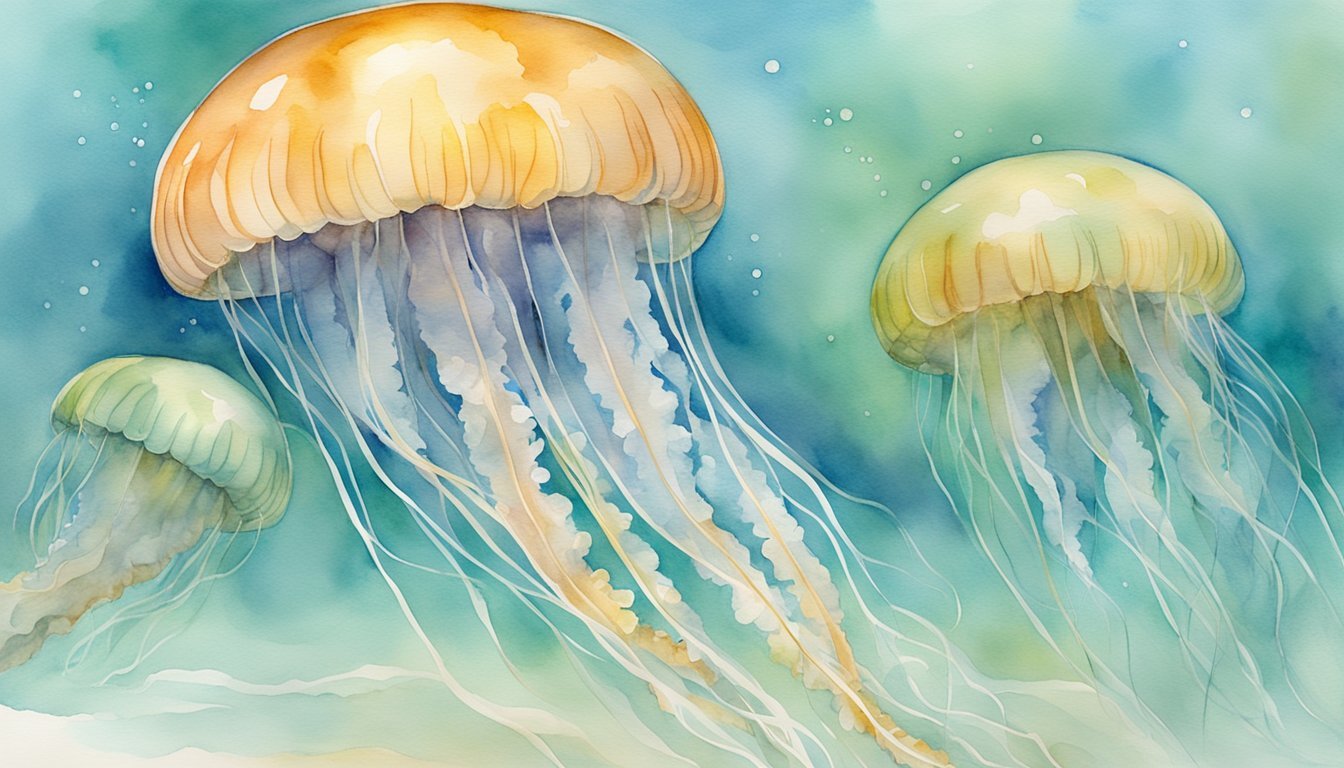Understanding Jellyfish in Florida
Florida’s coastal waters are home to a myriad of jellyfish species. These creatures are known for their distinctive gelatinous bodies and their varying degrees of stinging capabilities.
Species Identification
Florida waters host several species including the common Moon Jellyfish and the robust Cannonball Jellyfish. Notably, the Portuguese Man-O’ War, often mistaken for a jellyfish, can also be found here. Dangerous species like the Box Jellyfish and Mauve Stinger are less common but present in the region. Residents and visitors may encounter species like the Sea Nettle Jellyfish, Purple Jellyfish, or Atlantic Sea Nettle Jellyfish during a swim.
Habitat and Distribution
Jellyfish inhabit diverse zones in Florida’s marine environments, ranging from shallow bays to the open ocean. The Moon Jellyfish prefers warmer coastal waters, while the Cannonball Jellyfish often washes up on beaches. The Blue Button Jellyfish is not a true jellyfish but shares a similar habitat along the coast.
Physical Characteristics
Jellyfish in Florida display an array of physical features. The Moon Jellyfish has a translucent body with a white center, growing up to 40 centimeters in diameter. In contrast, the bell of a Cannonball Jellyfish can reach 10 inches across. The Portuguese Man-O’ War is recognized by its balloon-like float and long, painful tentacles.
Life Cycle and Reproduction
The life cycle of jellyfish consists of both a stationary polyp stage and a free-swimming medusa stage. Moon Jellyfish undergo a simple life cycle, releasing planula larvae which settle and form new polyps. Cannonball jellyfish have a similar reproductive process, involving external fertilization in the water column.
Health and Safety Concerns

When enjoying the beautiful beaches of Florida, it’s crucial to be aware of jellyfish and the potential health risks they pose. Their stings can cause significant discomfort, and in some cases, severe allergic reactions.
Jellyfish Stings and First Aid
Jellyfish stings are a common issue on Florida’s coastlines, especially during blooms. Their tentacles contain stinging cells called nematocysts, which release venom upon contact. If stung, one should exit the water and avoid rubbing the area, as this may increase venom release. Rinse the affected area with vinegar to alleviate pain and deactivate any remaining nematocysts. Remove tentacles with a fine object like tweezers— not bare hands. For severe reactions, such as difficulty breathing or chest pain, seek emergency medical attention immediately. Volusia County Beach Safety reported at least 200 jellyfish stings over a week during the summer of 2022, emphasizing the need for prompt first aid.
Prevention and Protection
To prevent jellyfish stings, beachgoers are encouraged to wear protective clothing such as wetsuits or rash guards while swimming. Lifeguards often fly purple flags to warn of dangerous marine life, including jellyfish like the Portuguese man-of-war, known for its painful sting. It’s also advised to keep an eye out for jellyfish on the sand since they can still sting if the tentacles are wet. NOAA’s National Ocean Service provides information on how to spot and what to do regarding jellyfish on beaches.
Environmental Factors and Jellyfish Blooms
Strong winds and ocean currents are known to contribute to jellyfish blooms along Florida beaches. These blooms can lead to increased encounters between swimmers and jellyfish, causing a surge in stings. Environmental changes, such as warmer water temperatures and changes in sea currents, can also increase jellyfish populations. Understanding these environmental factors is critical for managing and mitigating the risks associated with jellyfish blooms.

